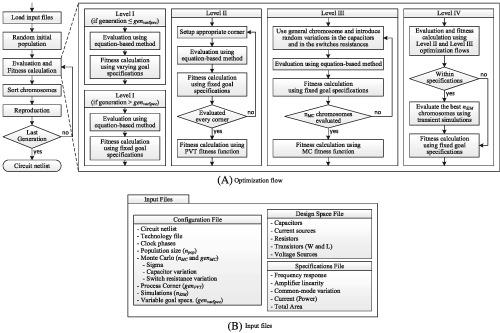当前位置:
X-MOL 学术
›
Int. J. Circ. Theory Appl.
›
论文详情
Our official English website, www.x-mol.net, welcomes your
feedback! (Note: you will need to create a separate account there.)
Transistor‐level optimization methodology for the complete design of switched‐capacitor filter circuits
International Journal of Circuit Theory and Applications ( IF 1.8 ) Pub Date : 2020-10-21 , DOI: 10.1002/cta.2891 Hugo Serra 1, 2, 3 , Rui Santos‐Tavares 1, 2 , Nuno Paulino 1, 2
International Journal of Circuit Theory and Applications ( IF 1.8 ) Pub Date : 2020-10-21 , DOI: 10.1002/cta.2891 Hugo Serra 1, 2, 3 , Rui Santos‐Tavares 1, 2 , Nuno Paulino 1, 2
Affiliation

|
This paper presents an automatic procedure for the design and optimization of switched‐capacitor (SC) filters, including the automatic sizing of transistors in the amplifiers and switches. The optimization procedure is based on genetic algorithms (GAs) where the circuit's fitness is first computed using equations describing the filter's transfer function and then using transient simulations. These equations are obtained using a fast numerical methodology that takes into consideration the electrical behavior of all components in the circuit. The poles and zeros of the SC filter's transfer function are computed using a system of differential equations, obtained from the inspection of the circuit. This system describes the filter's behavior for all switch combinations, including the non‐ideal effects of the transistors in the switches and amplifiers. Due to the low computational effort and accuracy of this methodology, it is possible to use a large population in the GA. After finding a solution through equations, the more computationally intensive SPICE transient simulations are used to fine‐tune the solution, with a much smaller population in the GA. Taking advantage of the equations' low computational load and accuracy, process, voltage, temperature (PVT) corners and mismatch errors optimizations are also performed, allowing the chromosomes fitness to be calculated taking into consideration multiple cases, thus resulting in a low sensitivity design.
中文翻译:

晶体管级优化方法,用于开关电容滤波器电路的完整设计
本文提出了一种用于设计和优化开关电容器(SC)滤波器的自动程序,包括自动确定放大器和开关中晶体管的大小。优化过程基于遗传算法(GA),其中首先使用描述滤波器传递函数的方程式计算电路的适应度,然后再使用瞬态仿真。这些方程式是使用快速数值方法获得的,该方法考虑了电路中所有组件的电气行为。SC滤波器传递函数的零点和零点是使用微分方程组计算的,该微分方程组是从电路检查中获得的。该系统描述了所有开关组合的过滤器行为,包括开关和放大器中晶体管的非理想效应。由于该方法的计算量少且准确性低,因此有可能在GA中使用大量的种群。通过方程式找到解决方案后,需要使用计算量更大的SPICE瞬态仿真来对解决方案进行微调,而GA中的人口要小得多。利用等式的低计算量和准确性,还可以进行工艺,电压,温度(PVT)角和失配误差的优化,从而可以考虑多种情况来计算染色体适应度,从而导致低灵敏度设计。通过方程式找到解决方案后,需要使用计算量更大的SPICE瞬态仿真来对解决方案进行微调,而GA中的人口要小得多。利用等式的低计算量和准确性,还可以进行工艺,电压,温度(PVT)角和失配误差的优化,从而可以考虑多种情况来计算染色体适应度,从而导致低灵敏度设计。通过方程式找到解决方案后,需要使用计算量更大的SPICE瞬态仿真来对解决方案进行微调,而GA中的人口要小得多。利用等式的低计算量和准确性,还可以进行工艺,电压,温度(PVT)角和失配误差的优化,从而可以考虑多种情况来计算染色体适应度,从而导致低灵敏度设计。
更新日期:2020-10-21
中文翻译:

晶体管级优化方法,用于开关电容滤波器电路的完整设计
本文提出了一种用于设计和优化开关电容器(SC)滤波器的自动程序,包括自动确定放大器和开关中晶体管的大小。优化过程基于遗传算法(GA),其中首先使用描述滤波器传递函数的方程式计算电路的适应度,然后再使用瞬态仿真。这些方程式是使用快速数值方法获得的,该方法考虑了电路中所有组件的电气行为。SC滤波器传递函数的零点和零点是使用微分方程组计算的,该微分方程组是从电路检查中获得的。该系统描述了所有开关组合的过滤器行为,包括开关和放大器中晶体管的非理想效应。由于该方法的计算量少且准确性低,因此有可能在GA中使用大量的种群。通过方程式找到解决方案后,需要使用计算量更大的SPICE瞬态仿真来对解决方案进行微调,而GA中的人口要小得多。利用等式的低计算量和准确性,还可以进行工艺,电压,温度(PVT)角和失配误差的优化,从而可以考虑多种情况来计算染色体适应度,从而导致低灵敏度设计。通过方程式找到解决方案后,需要使用计算量更大的SPICE瞬态仿真来对解决方案进行微调,而GA中的人口要小得多。利用等式的低计算量和准确性,还可以进行工艺,电压,温度(PVT)角和失配误差的优化,从而可以考虑多种情况来计算染色体适应度,从而导致低灵敏度设计。通过方程式找到解决方案后,需要使用计算量更大的SPICE瞬态仿真来对解决方案进行微调,而GA中的人口要小得多。利用等式的低计算量和准确性,还可以进行工艺,电压,温度(PVT)角和失配误差的优化,从而可以考虑多种情况来计算染色体适应度,从而导致低灵敏度设计。











































 京公网安备 11010802027423号
京公网安备 11010802027423号